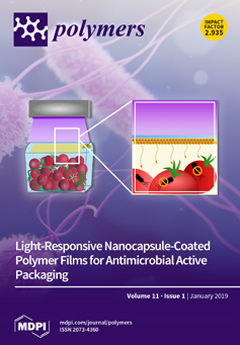Open AccessEditor’s ChoiceArticle
Biocompatibility of Small-Diameter Vascular Grafts in Different Modes of RGD Modification
by
Larisa V. Antonova, Vladimir N. Silnikov, Victoria V. Sevostyanova, Arseniy E. Yuzhalin, Lyudmila S. Koroleva, Elena A. Velikanova, Andrey V. Mironov, Tatyana S. Godovikova, Anton G. Kutikhin, Tatiana V. Glushkova, Inna Yu. Serpokrylova, Evgeniya A. Senokosova, Vera G. Matveeva, Mariam Yu. Khanova, Tatiana N. Akentyeva, Evgeniya O. Krivkina, Yulia A. Kudryavtseva and Leonid S. Barbarash
Cited by 22 | Viewed by 4939
Abstract
Modification with Arg-Gly-Asp (RGD) peptides is a promising approach to improve biocompatibility of small-calibre vascular grafts but it is unknown how different RGD sequence composition impacts graft performance. Here we manufactured 1.5 mm poly(3-hydroxybutyrate-
co-3-hydroxyvalerate)/poly(ε-caprolactone) grafts modified by distinct linear or cyclic
[...] Read more.
Modification with Arg-Gly-Asp (RGD) peptides is a promising approach to improve biocompatibility of small-calibre vascular grafts but it is unknown how different RGD sequence composition impacts graft performance. Here we manufactured 1.5 mm poly(3-hydroxybutyrate-
co-3-hydroxyvalerate)/poly(ε-caprolactone) grafts modified by distinct linear or cyclic RGD peptides immobilized by short or long amine linker arms. Modified vascular prostheses were tested in vitro to assess their mechanical properties, hemocompatibility, thrombogenicity and endothelialisation. We also implanted these grafts into rat abdominal aortas with the following histological examination at 1 and 3 months to evaluate their primary patency, cellular composition and detect possible calcification. Our results demonstrated that all modes of RGD modification reduce ultimate tensile strength of the grafts. Modification of prostheses does not cause haemolysis upon the contact with modified grafts, yet all the RGD-treated grafts display a tendency to promote platelet aggregation in comparison with unmodified counterparts. In vivo findings identify that cyclic Arg-Gly-Asp-Phe-Lys peptide in combination with trioxa-1,13-tridecanediamine linker group substantially improve graft biocompatibility. To conclude, here we for the first time compared synthetic small-diameter vascular prostheses with different modes of RGD modification. We suggest our graft modification regimen as enhancing graft performance and thus recommend it for future use in tissue engineering.
Full article
►▼
Show Figures






